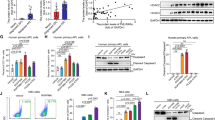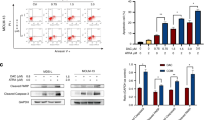Abstract
Acute promyelocytic leukemia (APL) is a M3 subtype of acute myeloid leukemia (AML). Promyelocytic leukemia (PML)-retinoic acid receptor α (RARα) translocation generally occurs in APL patients and makes APL unique both for diagnosis and treatment. However, some conventional drugs like all-transretinoic acid (ATRA) and arsenic trioxide (ATO), as the preferred ones for APL therapy, induce irreversible resistance and responsible for clinical failure of complete remission. Herein, we screened a library of novel chemical compounds with structural diversity and discovered a novel synthetic small compound, named LG-362B, specifically inhibited the proliferation of APL and induced apoptosis. Notably, the differentiation arrest was also relieved by LG-362B in cultured APL cells and APL mouse models. Moreover, LG-362B overcame the ATRA resistance on cellular differentiation and transplantable APL mice. These positive effects were driven by caspases-mediated degradation of PML-RARα when treated with LG-362B, making it specific to APL and reasonable for ATRA resistance relief. We propose that LG-362B would be a potential candidate agent for the treatment of the relapsed APL with ATRA resistance in the future.
This is a preview of subscription content, access via your institution
Access options
Subscribe to this journal
Receive 12 print issues and online access
$259.00 per year
only $21.58 per issue
Buy this article
- Purchase on Springer Link
- Instant access to full article PDF
Prices may be subject to local taxes which are calculated during checkout






Similar content being viewed by others
References
Park JH, Qiao B, Panageas KS, Schymura MJ, Jurcic JG, Rosenblat TL et al. Early death rate in acute promyelocytic leukemia remains high despite all-trans retinoic acid. Blood 2011; 118: 1248–1254.
Wang ZY, Chen Z . Acute promyelocytic leukemia: from highly fatal to highly curable. Blood 2008; 111: 2505–2515.
Vickers M, Jackson G, Taylor P . The incidence of acute promyelocytic leukemia appears constant over most of a human lifespan, implying only one rate limiting mutation. Leukemia 2000; 14: 722–726.
Manjarrez ME, Ocadiz R, Valle L, Pacheco C, Marroquin A, De la Torre C et al. Detection of human papillomavirus and relevant tumor suppressors and oncoproteins in laryngeal tumors. Clin Cancer Res 2006; 12: 6946–6951.
Kuis D, Sciran I, Lajnert V, Snjaric D, Prpic J, Pezelj-Ribaric S et al. Coronally advanced flap alone or with connective tissue graft in the treatment of single gingival recession defects: a long-term randomized clinical trial. J Periodontol 2013; 84: 1576–1585.
Chen J, Ye X, Li Y, Wei C, Zheng Q, Zhong P et al. [Chromosomal translocation involving USP6 gene in nodular fasciitis]. Zhonghua bing li xue za zhi Chin J Pathol 2014; 43: 533–536.
Zarina AL, Jamil MA, Ng SP, Rohana J, Yong SC, Salwati S et al. Unbalanced chromosomal translocation: a cause of recurrent spontaneous abortion. Med J Malaysia 2006; 61: 260–262.
Mengeling BJ, Phan TQ, Goodson ML, Privalsky ML . Aberrant corepressor interactions implicated in PML-RAR(alpha) and PLZF-RAR(alpha) leukemogenesis reflect an altered recruitment and release of specific NCoR and SMRT splice variants. J Biol Chem 2011; 286: 4236–4247.
Okazuka K, Masuko M, Seki Y, Hama H, Honma N, Furukawa T et al. Successful all-trans retinoic acid treatment of acute promyelocytic leukemia in a patient with NPM/RAR fusion. Int J Hematol 2007; 86: 246–249.
Rush EA, Pollock SL, Abecassis I, Redner RL . Interaction with RXR is necessary for NPM-RAR-induced myeloid differentiation blockade. Leuk Res 2013; 37: 1704–1710.
de Botton S, Chevret S, Coiteux V, Dombret H, Sanz M, San Miguel J et al. Early onset of chemotherapy can reduce the incidence of ATRA syndrome in newly diagnosed acute promyelocytic leukemia (APL) with low white blood cell counts: results from APL 93 trial. Leukemia 2003; 17: 339–342.
Sanz MA, Grimwade D, Tallman MS, Lowenberg B, Fenaux P, Estey EH et al. Management of acute promyelocytic leukemia: recommendations from an expert panel on behalf of the European LeukemiaNet. Blood 2009; 113: 1875–1891.
de The H, Chen Z . Acute promyelocytic leukaemia: novel insights into the mechanisms of cure. Nat Rev Cancer 2010; 10: 775–783.
Liu TX, Zhang JW, Tao J, Zhang RB, Zhang QH, Zhao CJ et al. Gene expression networks underlying retinoic acid-induced differentiation of acute promyelocytic leukemia cells. Blood 2000; 96: 1496–1504.
Tomita A, Kiyoi H, Naoe T . Mechanisms of action and resistance to all-trans retinoic acid (ATRA) and arsenic trioxide (As2O 3) in acute promyelocytic leukemia. Int J Hemat 2013; 97: 717–725.
Lo-Coco F, Avvisati G, Vignetti M, Thiede C, Orlando SM, Iacobelli S et al. Retinoic acid and arsenic trioxide for acute promyelocytic leukemia. N Engl J Med 2013; 369: 111–121.
Coombs CC, Tavakkoli M, Tallman MS . Acute promyelocytic leukemia: where did we start, where are we now, and the future. Blood Cancer J 2015; 5: e304.
Burnett AK, Russell NH, Hills RK, Bowen D, Kell J, Knapper S et al. Arsenic trioxide and all-trans retinoic acid treatment for acute promyelocytic leukaemia in all risk groups (AML17): results of a randomised, controlled, phase 3 trial. Lancet Oncol 2015; 16: 1295–1305.
Iland HJ, Collins M, Bradstock K, Supple SG, Catalano A, Hertzberg M et al. Use of arsenic trioxide in remission induction and consolidation therapy for acute promyelocytic leukaemia in the Australasian Leukaemia and Lymphoma Group (ALLG) APML4 study: a non-randomised phase 2 trial. Lancet Haematol 2015; 2: e357–e366.
Zhu HH, Qin YZ, Huang XJ . Resistance to arsenic therapy in acute promyelocytic leukemia. N Engl J Med 2014; 370: 1864–1866.
Sanford D, Lo-Coco F, Sanz MA, Di Bona E, Coutre S, Altman JK et al. Tamibarotene in patients with acute promyelocytic leukaemia relapsing after treatment with all-trans retinoic acid and arsenic trioxide. Br J Haematol 2015; 171: 471–477.
Kelaidi C, Ades L, Chevret S, Sanz M, Guerci A, Thomas X et al. Late first relapses in APL treated with all-trans-retinoic acid- and anthracycline- based chemotherapy: the European APL group experience (APL 91 and APL 93 trials). Leukemia 2006; 20: 905–907.
Gallagher RE . Retinoic acid resistance in acute promyelocytic leukemia. Leukemia 2002; 16: 1940–1958.
Zheng C, Fang Y, Tong W, Li G, Wu H, Zhou W et al. Synthesis and biological evaluation of novel tetrahydro-beta-carboline derivatives as antitumor growth and metastasis agents through inhibiting the transforming growth factor-beta signaling pathway. J Med Chem 2014; 57: 600–612.
Roussel MJ, Lanotte M . Maturation sensitive and resistant t(15;17) NB4 cell lines as tools for APL physiopathology: nomenclature of cells and repertory of their known genetic alterations and phenotypes. Oncogene 2001; 20: 7287–7291.
Bucur O, Stancu AL, Khosravi-Far R, Almasan A . Analysis of apoptosis methods recently used in Cancer Research and Cell Death & Disease publications. Cell Death Dis 2012; 3: e263.
Teerasaksilp S, Wiwanitkit V, Lekngam P . Comparative study of blood cell staining with Wright-Giemsa stain, field stain, and a new modified stain. Lab Hematol 2005; 11: 76–78.
He P, Liu Y, Zhang M, Wang X, Xi J, Wu D et al. Interferon-gamma enhances promyelocytic leukemia protein expression in acute promyelocytic cells and cooperates with all-trans-retinoic acid to induce maturation of NB4 and NB4-R1 cells. Exp Ther Med 2012; 3: 776–780.
Yao CJ, Yang CM, Chuang SE, Yan JL, Liu CY, Chen SW et al. Targeting PML-RARalpha and oncogenic signaling pathways by Chinese herbal mixture Tien-Hsien liquid in acute promyelocytic leukemia NB4 cells. Evid Based Complement Alternat Med 2011; 2011: 984154.
Fukuyo Y, Inoue M, Nakajima T, Higashikubo R, Horikoshi NT, Hunt C et al. Oxidative stress plays a critical role in inactivating mutant BRAF by geldanamycin derivatives. Cancer Res 2008; 68: 6324–6330.
Liu CX, Yin QQ, Zhou HC, Wu YL, Pu JX, Xia L et al. Adenanthin targets peroxiredoxin I and II to induce differentiation of leukemic cells. Nat Chem Biol 2012; 8: 486–493.
Mi JQ, Li JM, Shen ZX, Chen SJ, Chen Z . How to manage acute promyelocytic leukemia. Leukemia 2012; 26: 1743–1751.
Marstrand TT, Borup R, Willer A, Borregaard N, Sandelin A, Porse BT et al. A conceptual framework for the identification of candidate drugs and drug targets in acute promyelocytic leukemia. Leukemia 2010; 24: 1265–1275.
Erkel G, Gehrt A, Anke T, Sterner O . Induction of differentiation in acute promyelocytic leukemia cells (HL-60) by the verticillin derivative Sch 52900. Zeitschrift fur Naturforschung C J Biosci 2002; 57: 759–767.
Durak I, Yurtarslanl Z, Canbolat O, Akyol O . A methodological approach to superoxide dismutase (SOD) activity assay based on inhibition of nitroblue tetrazolium (NBT) reduction. Clin Chim Acta; Int J Clin Chem 1993; 214: 103–104.
Winkler IG, Pettit AR, Raggatt LJ, Jacobsen RN, Forristal CE, Barbier V et al. Hematopoietic stem cell mobilizing agents G-CSF, cyclophosphamide or AMD3100 have distinct mechanisms of action on bone marrow HSC niches and bone formation. Leukemia 2012; 26: 1594–1601.
Tesio M, Oser GM, Baccelli I, Blanco-Bose W, Wu H, Gothert JR et al. Pten loss in the bone marrow leads to G-CSF-mediated HSC mobilization. J Exp Med 2013; 210: 2337–2349.
Ravindranath Y, Gregory J, Feusner J . Treatment of acute promyelocytic leukemia in children: arsenic or ATRA. Leukemia 2004; 18: 1576–1577.
Nika E, Brugnoli F, Piazzi M, Lambertini E, Grassilli S, Bavelloni A et al. hnRNP K in PU.1-containing complexes recruited at the CD11b promoter: a distinct role in modulating granulocytic and monocytic differentiation of AML-derived cells. Biochem J 2014; 463: 115–122.
Li X, Guo H, Duan H, Yang Y, Meng J, Liu J et al. Improving chemotherapeutic efficiency in acute myeloid leukemia treatments by chemically synthesized peptide interfering with CXCR4/CXCL12 axis. Sci Rep 2015; 5: 16228.
Chan IT, Kutok JL, Williams IR, Cohen S, Moore S, Shigematsu H et al. Oncogenic K-ras cooperates with PML-RAR alpha to induce an acute promyelocytic leukemia-like disease. Blood 2006; 108: 1708–1715.
Saboo SS, Krajewski KM, O'Regan KN, Giardino A, Brown JR, Ramaiya N et al. Spleen in haematological malignancies: spectrum of imaging findings. Br J Radiol 2012; 85: 81–92.
Zayed A, Couban S, Hayne O, Sparavalo N, Shawwa A, Sadek I et al. Acute promyelocytic leukemia: a novel PML/RARalpha fusion that generates a frameshift in the RARalpha transcript and ATRA resistance. Leuk Lymphoma 2007; 48: 489–496.
Chee LC, Hendy J, Purton LE, McArthur GA . ATRA and the specific RARalpha agonist, NRX195183, have opposing effects on the clonogenicity of pre-leukemic murine AML1-ETO bone marrow cells. Leukemia 2013; 27: 1369–1380.
Huan SY, Yang CH, Chen YC . Arsenic trioxide therapy for relapsed acute promyelocytic leukemia: an useful salvage therapy. Leuk Lymphoma 2000; 38: 283–293.
Zhang X, Yang XR, Sun C, Hu B, Sun YF, Huang XW et al. Promyelocytic leukemia protein induces arsenic trioxide resistance through regulation of aldehyde dehydrogenase 3 family member A1 in hepatocellular carcinoma. Cancer Lett 2015; 366: 112–122.
Chendamarai E, Ganesan S, Alex AA, Kamath V, Nair SC, Nellickal AJ et al. Comparison of newly diagnosed and relapsed patients with acute promyelocytic leukemia treated with arsenic trioxide: insight into mechanisms of resistance. PloS One 2015; 10: e0121912.
Acknowledgements
This study was partially supported by Major State Basic Research Development Program of China (2015CB910400 and 2012CB910404), National Natural Science Foundation of China (81472788, 81272463, 81202407 and 81330049), National Major Scientific and Technological Special Project for ‘Significant New Drugs Development’ (2013ZX09507001), Innovation Program of Shanghai Municipal Education Commission (13zz034), the Science and Technology Commission of Shanghai Municipality (15431902200) and the Youth Innovation Promotion Association (CAS 2015224).
Author information
Authors and Affiliations
Corresponding authors
Ethics declarations
Competing interests
The authors declare no conflict of interest.
Additional information
Supplementary Information accompanies this paper on the Leukemia website
Supplementary information
Rights and permissions
About this article
Cite this article
Wang, X., Lin, Q., Lv, F. et al. LG-362B targets PML-RARα and blocks ATRA resistance of acute promyelocytic leukemia. Leukemia 30, 1465–1474 (2016). https://doi.org/10.1038/leu.2016.50
Received:
Revised:
Accepted:
Published:
Issue Date:
DOI: https://doi.org/10.1038/leu.2016.50
This article is cited by
-
Targeting HDAC3 to overcome the resistance to ATRA or arsenic in acute promyelocytic leukemia through ubiquitination and degradation of PML-RARα
Cell Death & Differentiation (2023)



